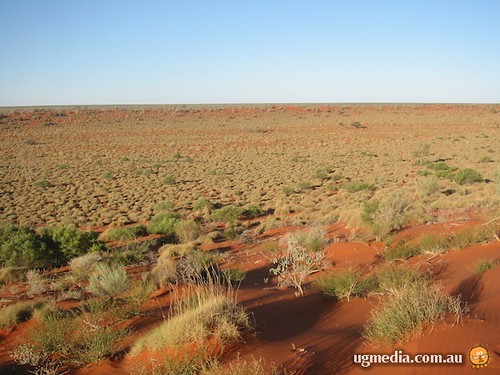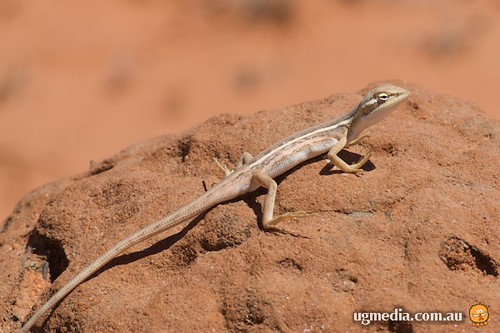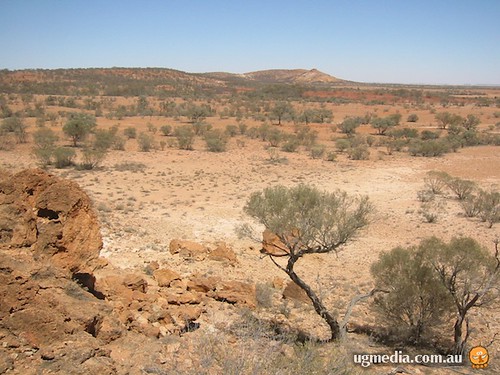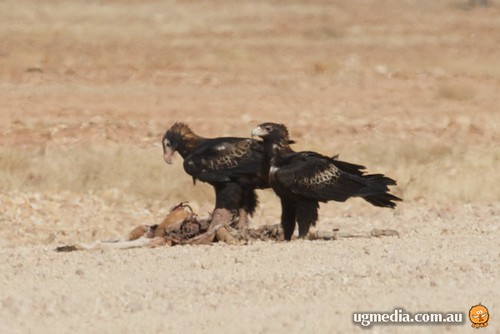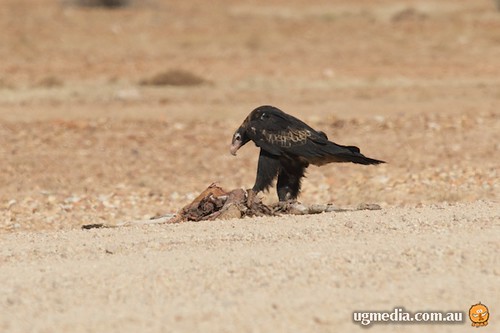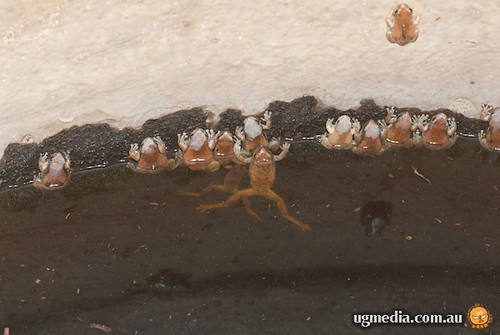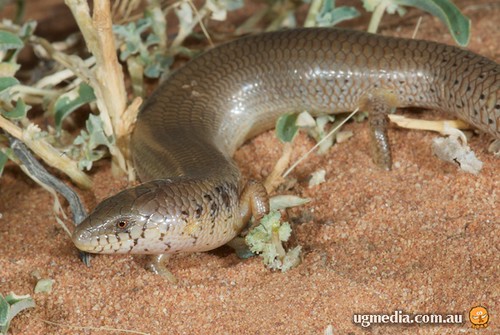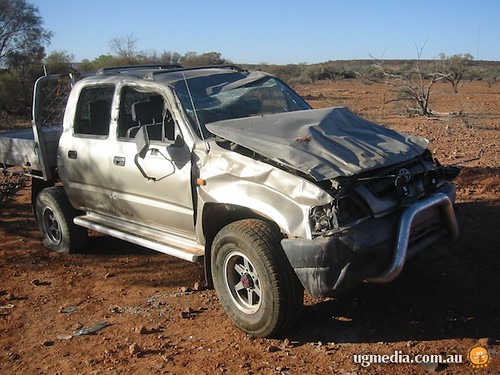smacdonald
Well-Known Member
I'm a ticker (as my recent Quest for 250 saga shows). I have a list of reptiles that I've seen. I like adding to my list. I woke up one day in early October and realised I'd never seen Cyclodomorphus venustus. This both shocked and worried me. What if I got hit by a bus today? Was I really happy knowing that I could die at any moment without seeing what is unarguably the most immaculate of all the Cyclodomorphuses? Of course not. But what to do about it? Jumping out of bed, I grabbed my phone and dialed.
"Hello, Jonno speaking." My good friend and mentor, Jonno Lucas from Educational Reptile Displays, answered the phone. I knew if anyone could find me my target species, it was Jonno.
"Jonno! It's me, Stewart", said me, Stewart. "I've just realised that I've never seen Cyclodomorphus venustus. Can you help?"
"No worries. I know a spot. I'll pick you up in half an hour."
After grabbing my swag, my camera gear and three kilograms of gummi bears, I waited out the front of my house. Thirty-six hours later, Jonno arrived. I tossed my gear in the tray of his ute and climbed aboard.
"So where's this spot?", I asked.
"About 100 kilometres west of Windorah."
"Windorah?!?? That's 1300 kilometres away! It'll take at least..." I did some quick calculations in my head. "...14 hours to get there."
Jonno dumped the clutch and said "That sounds like a challenge."
Eight and a half hours later we pulled up at the Western Star hotel in Windorah. These outback pubs are well known for having young, attractive, female European backpackers working at them. Sure enough, there was a cute young Irish girl smiling at us from behind the bar. We'd have to turn the testosterone up to eleven. I ordered a can of creamy soda and Jonno ordered a watermelon vodka cruiser. Jonno already has a devastatingly attractive girlfriend, so it was all up to me. Just as well, as I can't compete with his ponytail and earrings. The Irish lass had been in Australian for just a few weeks before getting the job in Windorah. Unfortunately, she'd been hit on by every guy who'd entered the pub since she arrived and as such, the Irish lass wasn't in the least bit interested in talking to me. Story of my life, really. At least I still had Jonno.
We downed our drinks and then hit the road again. It was still a few hours before sunset and it was still toasty warm outside. The plan was to drive out of town and see what we could see, before camping overnight and getting to our ultimate destination the next morning. We saw a number of critters on or beside the road.
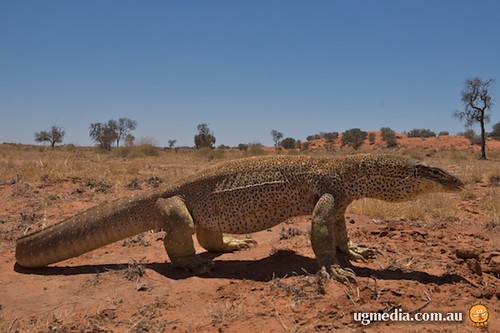
Yellow-spotted monitor (Varanus panoptes)
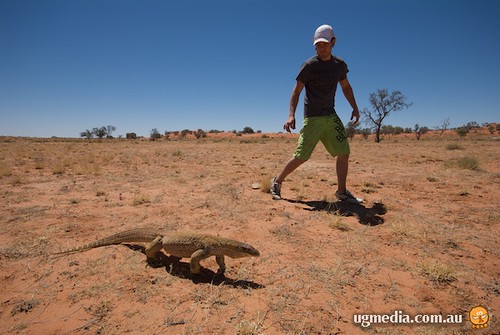
Yellow-spotted monitor (Varanus panoptes)
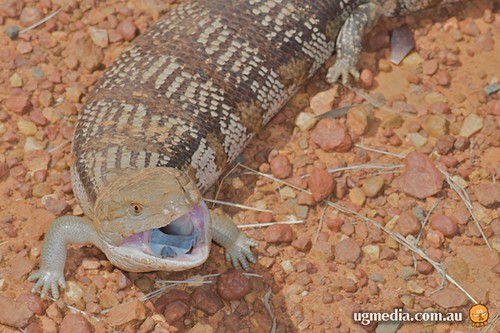
Eastern blue-tongued skink (Tiliqua scincoides scincoides)

Inland bearded dragon (Pogona vitticeps)

Inland bearded dragon (Pogona vitticeps)

Inland bearded dragon (Pogona vitticeps)
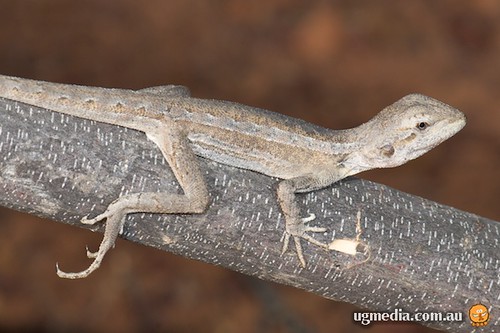
Burns' dragon (Amphibolurus burnsi)
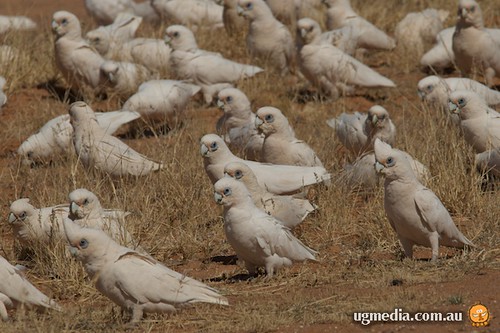
Little corella (Cacatua sanguinea) flock

Little corella (Cacatua sanguinea) flock
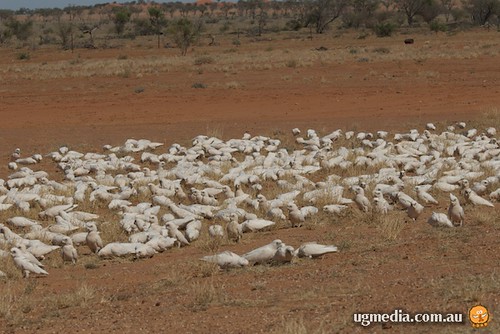
Little corella (Cacatua sanguinea) flock
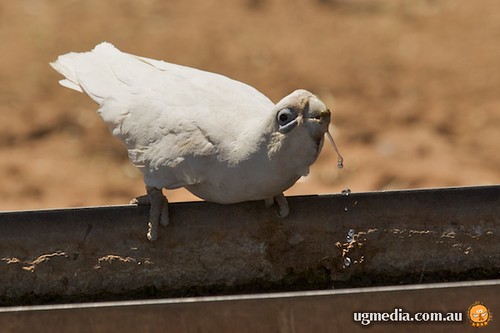
Little corellas (Cacatua sanguinea)
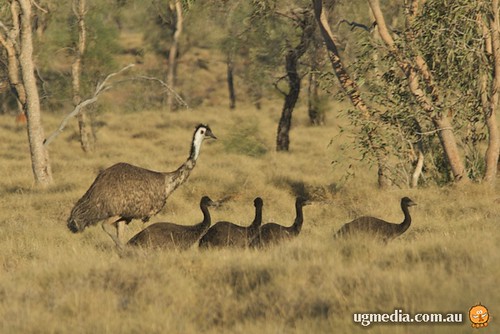
Emus (Dromaius novaehollandiae). Dad and chicks.

Spinifex pigeon (Geophaps plumifera)
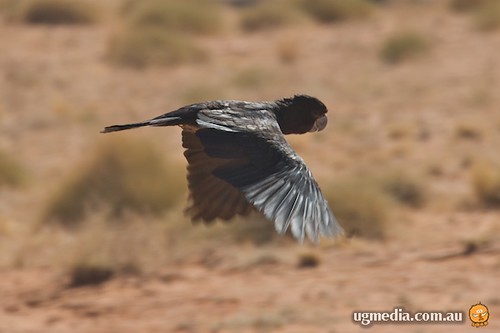
Red-tailed black-cockatoo (Calyptorhynchus banksii)
As night approached, the temperature dropped rapidly. We still managed to find a couple of critters out and about just after sunset.
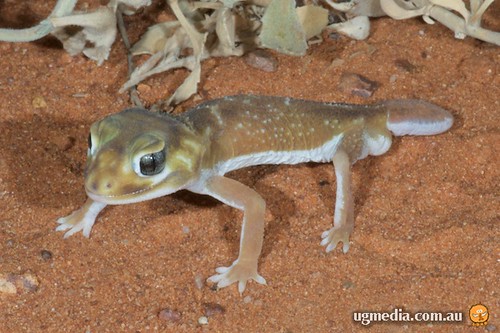
Smooth knob-tailed gecko (Nephrurus levis)
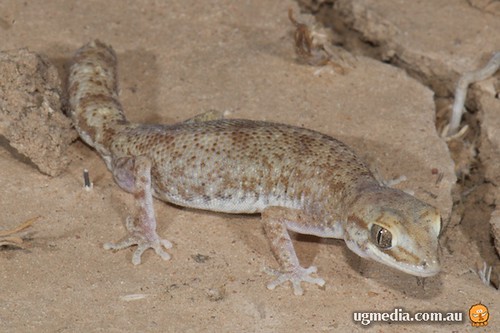
Tessellated gecko (Diplodactylus tessellatus)
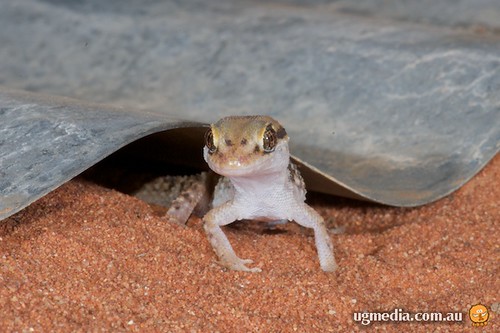
Bynoe's gecko (Heteronotia binoei)
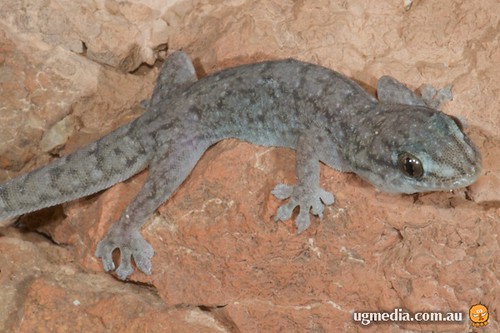
Gehyra variegata
It was late and we were both feeling light headed (Jonno from his one cruiser, and me from the sweet smell of Guinness and potatoes that emanated from that pretty Irish lass) so we pitched our swags on the side of the road amongst the red sand and spinifex.
"Jonno?", I said, lying in my swag.
"Yes?"
"Goodnight."
"Goodnight, Stew."
That night my dreams were filled with images of four-leafed clovers, fossorial skinks and speed cameras. The next morning I awoke to a breathtaking view across the sand dunes. The dunes were covered in animal trackways from the previous night, and there were dragons and skinks running everywhere in the morning sunshine. Unfortunately they were running pretty fast, so I managed the photograph only a canegrass dragon (Diporiphora winneckei).
We rolled up our swags and packed the car. As we drove off, Jonno told me it would be only another hour or so until we'd reach our destination. My heart skipped a beat at the thought of finally seeing a Cyclodomorphus venustus. We were now traveling across the Morney Plain, a flat, featureless expanse of gibber and cracking black soil.
The Morney Plain is not well known for any one particular reptile species, but the deep soil cracks provide excellent shelter for a variety of small critters. As we drove west, Jonno spotted movement about 200 metres off the side of the road. We raced over to the spot and found a small Eyrean earless dragon (Tympanocryptis tetraporophora) down a soil crack. I wanted to get some decent photos of it, so I set up camp next to the soil crack while Jonno went looking for nothing in particular.
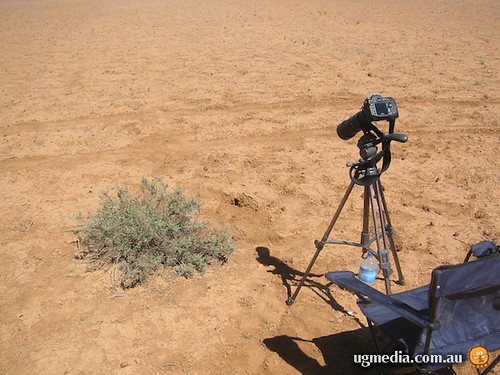
Waiting patiently for a Tympanocryptis tetraporophora to emerge from his burrow. He didn't.
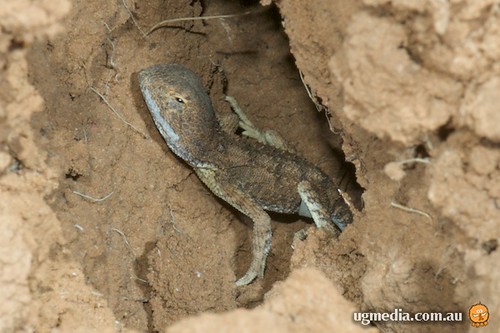
Eyrean earless dragon (Tympanocryptis tetraporophora)
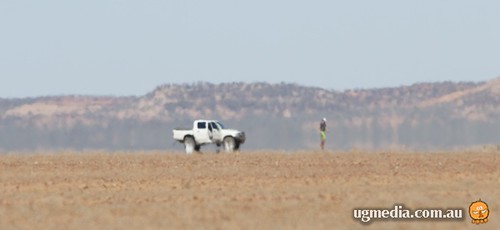
Going walkabout on the Morney Plain.
I spent about an hour in the blazing sun waiting for the little dragon to emerge, but he refused to cooperate. He remained motionless and unphotographable down his soil crack for the entire time. Jonno eventually tired of looking for nothing in particular and returned to collect me. We continued on to venustus central, all the while keeping our eyes on the road for nothing in particular.
"So how do you know about this venustus spot?", I asked, complete with italicisation.
"I read a forum post by this guy called Dr Danny Brown. He's the world's leading authority on obscure Australian reptile species. He discovered this spot in 2005 while out here on a bilby survey."
"So this information is reliable?"
"Yeah. Danny really knows what he's talking about. He's so knowledgeable, he could write a book. It'd probably only take him a few months."
"Well," I said. "Let's hope he...". I was cut off before I could finish.
"Listen! Do you smell that?", asked Jonno.
"What?"
"There's something on the road ahead."
Sure enough, as we crested the rise, a pair of wedge-tailed eagles, Aquila audax, came into view, feasting on a roo carcass on the road, and I decided to write, using as many commas as possible, about them upon my return. One of them took flight as we approached, but the other remained, his hunger obviously outweighing his caution.
We sat in the car hoping the other eagle would return, but eventually we decided to move on. After all, we had a date with a skink! Jonno told me we were looking for a bore with a concrete water tank beside it. Surrounding this water tank would be clumps of saltbush. One of these clumps would look slightly greener than the others. It was in this greener clump that we would find our quarry.
We continued driving, slower now. Up ahead in the distance I saw a shimmering light. Light reflecting off a water body. A waterbody in a concrete tank. A concrete tank surrounded by saltbush. We had arrived.
I was so nervous. So much waiting, so much anticipation, all about to come to an end. I decided to delay the moment a bit. I had a look in the water tank and found it brimming with desert tree frogs (Litoria rubella). Eventually I tore myself away from the frogs and focussed on the reason we'd just driven 1400 kilometres.
Dr Brown's information was spot on. Even at a distance we could see that one of the clumps of saltbush was more verdant than the others. We jumped out of the car and headed straight for it. Sure enough, exactly as predicted by the good doctor, there was a Cyclodomorphus venustus lounging in the saltbush. I took one picture, turned to Jonno, and we embraced. We'd accomplished our mission!
I could now die a happy man. And, given the way Jonno drives, there was good chance I would die on the drive back home. (See below for a picture of what happened on Jonno's last herping trip).
We drove back to Windorah, stopped for a honeycomb MaxiBon at the general store, and photographed some birds.

Black kite (Milvus migrans)
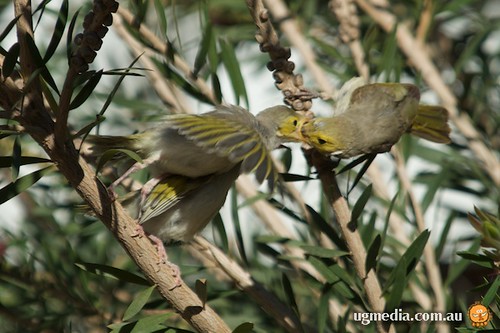
White-plumed honeyeater (Lichenostomus penicillatus). Mum and chicks.
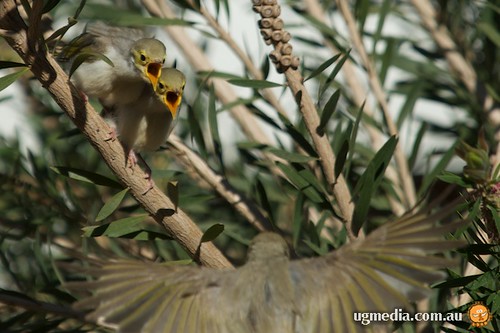
White-plumed honeyeater (Lichenostomus penicillatus). Mum and chicks.
Then we headed back home to Brisbane, still on a high after seeing the amazing Cyclodomorphus venustus.
"Hello, Jonno speaking." My good friend and mentor, Jonno Lucas from Educational Reptile Displays, answered the phone. I knew if anyone could find me my target species, it was Jonno.
"Jonno! It's me, Stewart", said me, Stewart. "I've just realised that I've never seen Cyclodomorphus venustus. Can you help?"
"No worries. I know a spot. I'll pick you up in half an hour."
After grabbing my swag, my camera gear and three kilograms of gummi bears, I waited out the front of my house. Thirty-six hours later, Jonno arrived. I tossed my gear in the tray of his ute and climbed aboard.
"So where's this spot?", I asked.
"About 100 kilometres west of Windorah."
"Windorah?!?? That's 1300 kilometres away! It'll take at least..." I did some quick calculations in my head. "...14 hours to get there."
Jonno dumped the clutch and said "That sounds like a challenge."
Eight and a half hours later we pulled up at the Western Star hotel in Windorah. These outback pubs are well known for having young, attractive, female European backpackers working at them. Sure enough, there was a cute young Irish girl smiling at us from behind the bar. We'd have to turn the testosterone up to eleven. I ordered a can of creamy soda and Jonno ordered a watermelon vodka cruiser. Jonno already has a devastatingly attractive girlfriend, so it was all up to me. Just as well, as I can't compete with his ponytail and earrings. The Irish lass had been in Australian for just a few weeks before getting the job in Windorah. Unfortunately, she'd been hit on by every guy who'd entered the pub since she arrived and as such, the Irish lass wasn't in the least bit interested in talking to me. Story of my life, really. At least I still had Jonno.
We downed our drinks and then hit the road again. It was still a few hours before sunset and it was still toasty warm outside. The plan was to drive out of town and see what we could see, before camping overnight and getting to our ultimate destination the next morning. We saw a number of critters on or beside the road.

Yellow-spotted monitor (Varanus panoptes)

Yellow-spotted monitor (Varanus panoptes)

Eastern blue-tongued skink (Tiliqua scincoides scincoides)

Inland bearded dragon (Pogona vitticeps)

Inland bearded dragon (Pogona vitticeps)

Inland bearded dragon (Pogona vitticeps)

Burns' dragon (Amphibolurus burnsi)

Little corella (Cacatua sanguinea) flock

Little corella (Cacatua sanguinea) flock

Little corella (Cacatua sanguinea) flock

Little corellas (Cacatua sanguinea)

Emus (Dromaius novaehollandiae). Dad and chicks.

Spinifex pigeon (Geophaps plumifera)

Red-tailed black-cockatoo (Calyptorhynchus banksii)
As night approached, the temperature dropped rapidly. We still managed to find a couple of critters out and about just after sunset.

Smooth knob-tailed gecko (Nephrurus levis)

Tessellated gecko (Diplodactylus tessellatus)

Bynoe's gecko (Heteronotia binoei)

Gehyra variegata
It was late and we were both feeling light headed (Jonno from his one cruiser, and me from the sweet smell of Guinness and potatoes that emanated from that pretty Irish lass) so we pitched our swags on the side of the road amongst the red sand and spinifex.
"Jonno?", I said, lying in my swag.
"Yes?"
"Goodnight."
"Goodnight, Stew."
That night my dreams were filled with images of four-leafed clovers, fossorial skinks and speed cameras. The next morning I awoke to a breathtaking view across the sand dunes. The dunes were covered in animal trackways from the previous night, and there were dragons and skinks running everywhere in the morning sunshine. Unfortunately they were running pretty fast, so I managed the photograph only a canegrass dragon (Diporiphora winneckei).
We rolled up our swags and packed the car. As we drove off, Jonno told me it would be only another hour or so until we'd reach our destination. My heart skipped a beat at the thought of finally seeing a Cyclodomorphus venustus. We were now traveling across the Morney Plain, a flat, featureless expanse of gibber and cracking black soil.
The Morney Plain is not well known for any one particular reptile species, but the deep soil cracks provide excellent shelter for a variety of small critters. As we drove west, Jonno spotted movement about 200 metres off the side of the road. We raced over to the spot and found a small Eyrean earless dragon (Tympanocryptis tetraporophora) down a soil crack. I wanted to get some decent photos of it, so I set up camp next to the soil crack while Jonno went looking for nothing in particular.

Waiting patiently for a Tympanocryptis tetraporophora to emerge from his burrow. He didn't.

Eyrean earless dragon (Tympanocryptis tetraporophora)

Going walkabout on the Morney Plain.
I spent about an hour in the blazing sun waiting for the little dragon to emerge, but he refused to cooperate. He remained motionless and unphotographable down his soil crack for the entire time. Jonno eventually tired of looking for nothing in particular and returned to collect me. We continued on to venustus central, all the while keeping our eyes on the road for nothing in particular.
"So how do you know about this venustus spot?", I asked, complete with italicisation.
"I read a forum post by this guy called Dr Danny Brown. He's the world's leading authority on obscure Australian reptile species. He discovered this spot in 2005 while out here on a bilby survey."
"So this information is reliable?"
"Yeah. Danny really knows what he's talking about. He's so knowledgeable, he could write a book. It'd probably only take him a few months."
"Well," I said. "Let's hope he...". I was cut off before I could finish.
"Listen! Do you smell that?", asked Jonno.
"What?"
"There's something on the road ahead."
Sure enough, as we crested the rise, a pair of wedge-tailed eagles, Aquila audax, came into view, feasting on a roo carcass on the road, and I decided to write, using as many commas as possible, about them upon my return. One of them took flight as we approached, but the other remained, his hunger obviously outweighing his caution.
We sat in the car hoping the other eagle would return, but eventually we decided to move on. After all, we had a date with a skink! Jonno told me we were looking for a bore with a concrete water tank beside it. Surrounding this water tank would be clumps of saltbush. One of these clumps would look slightly greener than the others. It was in this greener clump that we would find our quarry.
We continued driving, slower now. Up ahead in the distance I saw a shimmering light. Light reflecting off a water body. A waterbody in a concrete tank. A concrete tank surrounded by saltbush. We had arrived.
I was so nervous. So much waiting, so much anticipation, all about to come to an end. I decided to delay the moment a bit. I had a look in the water tank and found it brimming with desert tree frogs (Litoria rubella). Eventually I tore myself away from the frogs and focussed on the reason we'd just driven 1400 kilometres.
Dr Brown's information was spot on. Even at a distance we could see that one of the clumps of saltbush was more verdant than the others. We jumped out of the car and headed straight for it. Sure enough, exactly as predicted by the good doctor, there was a Cyclodomorphus venustus lounging in the saltbush. I took one picture, turned to Jonno, and we embraced. We'd accomplished our mission!
I could now die a happy man. And, given the way Jonno drives, there was good chance I would die on the drive back home. (See below for a picture of what happened on Jonno's last herping trip).
We drove back to Windorah, stopped for a honeycomb MaxiBon at the general store, and photographed some birds.

Black kite (Milvus migrans)

White-plumed honeyeater (Lichenostomus penicillatus). Mum and chicks.

White-plumed honeyeater (Lichenostomus penicillatus). Mum and chicks.
Then we headed back home to Brisbane, still on a high after seeing the amazing Cyclodomorphus venustus.




